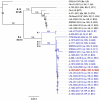Ulceroglandular form of tularemia after squirrel bite: a case report
- PMID: 35974355
- PMCID: PMC9381146
- DOI: 10.1186/s13256-022-03510-8
Ulceroglandular form of tularemia after squirrel bite: a case report
Abstract
Background: The diagnosis of tularemia is not often considered in Germany as the disease is still rare in this country. Nonetheless, Francisella tularensis, the causative agent of tularemia, can infect numerous animal species and should, therefore, not be neglected as a dangerous pathogen. Tularemia can lead to massively swollen lymph nodes and might even be fatal without antibiotic treatment. To our knowledge, the case described here is the first report of the disease caused by a squirrel bite in Germany.
Case presentation: A 59-year-old German woman with a past medical history of hypothyroidism and cutaneous lupus erythematosus presented at the emergency room at St. Katharinen Hospital with ongoing symptoms and a swollen right elbow persisting despite antibiotic therapy with cefuroxime for 7 days after she had been bitten (right hand) by a wild squirrel (Eurasian red squirrel). After another 7 days of therapy with piperacillin/tazobactam, laboratory analysis using real-time polymerase chain reaction (PCR) confirmed the suspected diagnosis of tularemia on day 14. After starting the recommended antibiotic treatment with ciprofloxacin, the patient recovered rapidly.
Conclusion: This is the first report of a case of tularemia caused by a squirrel bite in Germany. A naturally infected squirrel has recently been reported in Switzerland for the first time. The number of human cases of tularemia has been increasing over the last years and, therefore, tularemia should be taken into consideration as a diagnosis, especially in a patient bitten by an animal who also presents with headache, increasing pain, lymphadenitis, and fever, as well as impaired wound healing. The pathogen can easily be identified by a specific real-time PCR assay of wound swabs and/or by antibody detection, for example by enzyme-linked immunosorbent assay (ELISA), if the incident dates back longer than 2 weeks.
Keywords: Case report; Eurasian red squirrel; Francisella tularensis subspecies holarctica; Tularemia; Zoonosis.
© 2022. The Author(s).
Conflict of interest statement
The authors declare that they have no competing interests.
Figures


Similar articles
-
[Two cases of tick-borne tularemia in Yozgat province, Turkey].Mikrobiyol Bul. 2011 Oct;45(4):746-54. Mikrobiyol Bul. 2011. PMID: 22090307 Turkish.
-
[Prolonged course of tick-borne ulceroglandular tularemia in a 20-year-old patient in Germany--case report and review of the literature].Dtsch Med Wochenschr. 2009 Jul;134(27):1405-10. doi: 10.1055/s-0029-1225296. Epub 2009 Jun 23. Dtsch Med Wochenschr. 2009. PMID: 19551605 Review. German.
-
A case report of ulceroglandular tularemia caused by Francisella tularensis subsp. Holarctica in Iran.Acta Trop. 2022 Oct;234:106570. doi: 10.1016/j.actatropica.2022.106570. Epub 2022 Jun 22. Acta Trop. 2022. PMID: 35752204
-
A Rare Cause of Prosthetic Valve Infective Endocarditis: Francisella tularensis holarctica.WMJ. 2019 Dec;118(4):196-198. WMJ. 2019. PMID: 31978290
-
Neuroinvasive Francisella tularensis Infection: Report of 2 Cases and Review of the Literature.Clin Infect Dis. 2024 Jan 31;78(Suppl 1):S55-S63. doi: 10.1093/cid/ciad719. Clin Infect Dis. 2024. PMID: 38294117 Review.
Cited by
-
[Zoonoses in endemic, free-ranging mammals].Pathologie (Heidelb). 2023 Dec;44(Suppl 3):208-214. doi: 10.1007/s00292-023-01270-w. Epub 2023 Nov 21. Pathologie (Heidelb). 2023. PMID: 37987818 German.
-
Positive Francisella tularensis meningitis outcome despite delayed identification: a case report.Ann Clin Microbiol Antimicrob. 2023 Oct 24;22(1):92. doi: 10.1186/s12941-023-00642-7. Ann Clin Microbiol Antimicrob. 2023. PMID: 37875923 Free PMC article.
-
Squirrel bite-a rare cause of necrotizing soft tissue infection: Case report.Clin Case Rep. 2024 Jun 16;12(6):e9099. doi: 10.1002/ccr3.9099. eCollection 2024 Jun. Clin Case Rep. 2024. PMID: 38887307 Free PMC article.
-
Non-vaccinal prophylaxis of tularemia.Front Microbiol. 2024 Nov 28;15:1507469. doi: 10.3389/fmicb.2024.1507469. eCollection 2024. Front Microbiol. 2024. PMID: 39669787 Free PMC article. Review.
References
Publication types
MeSH terms
Substances
LinkOut - more resources
Full Text Sources
Miscellaneous

